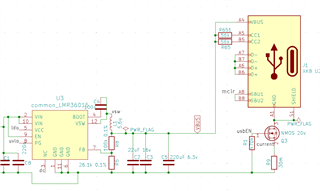Hi,
I'm currently prototyping with a 1MHz non-forced part which powers a small MCU and is switched into a USB load via a low side NMOS switch.
The MCU listens to the PG pin and if it receives a fault switches the USB out. On start-up there is a delay before the USB is switched in so that the LMR36015 is in PFM mode (MCU is a few mA max).
The LMR36015 has a typical 93% PG point, therefore to adhere to lower USB boundaries I've set the output to 4.85V nominal. If the voltage drops below 4.5v for the Tpg of 140us then PG will fire.
Specification
Input voltage: 10v, 4.7uF X7R 50v + 1000uF Elec 50v
Output: 4.85v, 2x 22uF 0805 X5R 16V, 220uF tantalum 6.3v
Inductor: Coilcraft XGL4030 5.6uH
Two issues have been observed.
One
A USB device should have only 10uH capacitance on it's output, but many violate this. When connected the 2x22uH 16v X5R's on the output immediately sag far quicker than the LMR36015 can keep up, which drops the 4.85v probably to half or less, which resets the MCU. To resolve this a 220uF 1ohm Tantalum has been added to the output.
Two
Most USB devices work well but the iPhone 8 is troublesome. It doesn't drop the voltage enough to reset the MCU but presents a load that is still enough the LMR36015 can't keep up with within the 140uS timeout.
Resolving
Low mA efficiency is not super critical. Will moving to the forced LMR36015 part tighten the timing as it switches from PFM to PWM and remove the issue of the problematic reset?


